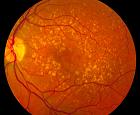
Researchers at UC Irvine in California have succeeded in getting stem cells to differentiate into a retina. The work was recently published online in the Journal of Neuroscience Methods, and represents the first 3D tissue structures made out of human embryonic stem cells (ESC). The group was lead by Hans Keirstead who is also developing the first US FDA approved therapy using ESC which seeks to treat spinal injuries. While still in the very early stages of development, the ESC-derived retinal tissue may help treat millions of people in the world that suffer from loss of vision due to macular degeneration and retinitis pigmentosa. This is yet another example of how stem cell derived therapies could revolutionize medicine.
There are roughly 10 million Americans with macular degeneration (and many more around the world), most of whom will suffer partial or complete loss of vision. There are several upcoming approaches to treating this type of blindness. A mechanical solution in the form of a telescope implanted into the eye has already had proven success and is awaiting FDA approval. Electrical artificial retinas connected directly to the body’s nerves are under development and have shown steady improvement in the last few years. Stem cells, however, offer the potential for either healing retinal damage in situ or replacing damaged tissue with newly grown retinal cells. UC Irvine’s work opens the door for both of these solutions by exploring what it takes to get ESCs to differentiate into the appropriate retinal cells.
That differentiation isn’t simple. The retina has a complex set of cell types that allow it to function. In order to foster the correct growth, the UC Irvine team placed the embryonic stem cells onto a patch of retinal pigment epithelium. The ESC were then bathed in a special gradient of solutions to promote growth into adult cells. The UC Irvine group found evidence of ganglion cells, photoreceptors, and more.
I really want to emphasize that this is very preliminary work, essentially a proof of concept. While Keirstead and others have a remarkable history of success with ESC, this work with retinal tissue is just the first step towards developing a meaningful therapy. The next stage will be testing in animal models (plans for that are already underway), and only after that is complete would we see human trials begin. We’re talking many years here.
Still, the retinal-ESC differentiation is a great sign of the advances in research that are likely to arise with the US’s renewed pursuit of embryonic stem cell technology. This work is some of the first to come out of UC Irvine’s new Sue and Bill Gross Stem Cell Research Center which opened last month. That center is home to a remarkable set of scientists including Hans Keirstead and the other authors on this paper: Gabriel Nistor, Magdalene J. Seiler, Fengrong Yana, and David Ferguson. Hopefully we’ll see much more out of the UC Irvine group in the years ahead as they enjoy continued funding by local, state, federal, and private institutions.
[image credit: National Institute of Health]
[source: UC Irvine News, Nistor et al JNM 2010]



